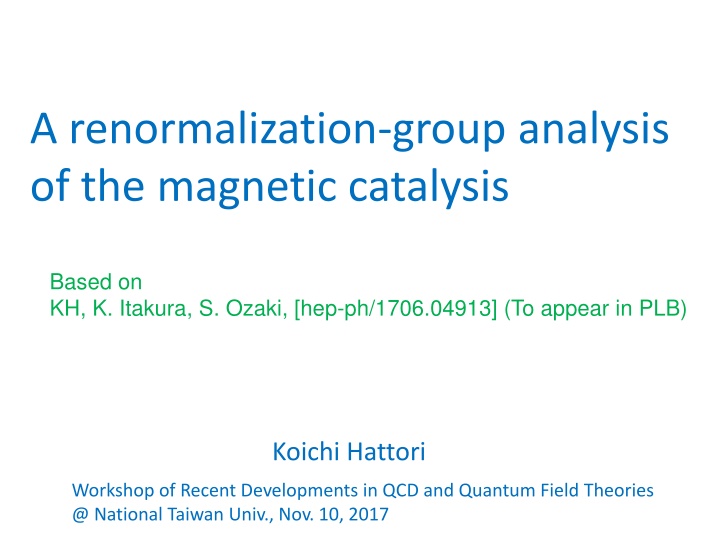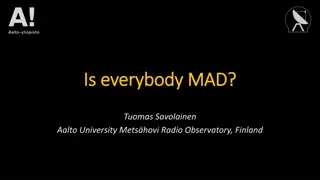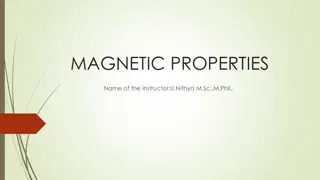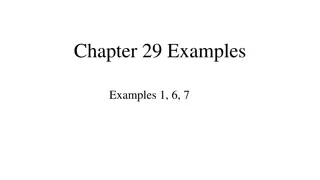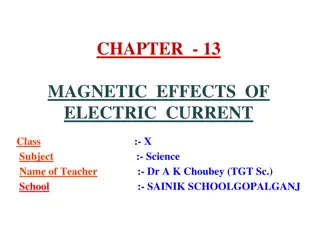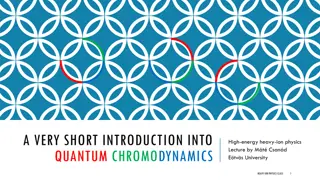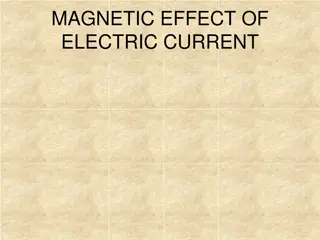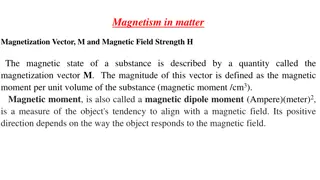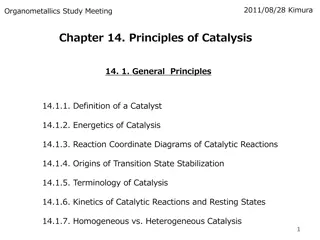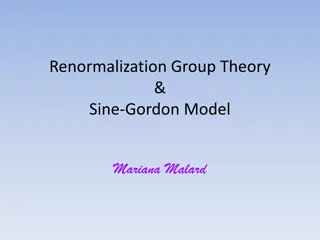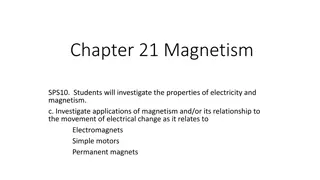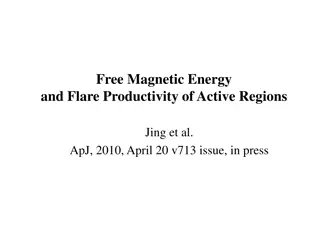Renormalization Group Analysis of Magnetic Catalysis in Quantum Field Theories
Explore the phenomenon of magnetic catalysis in strong magnetic fields through a renormalization group analysis, drawing parallels to superconductivity and dimensional reduction. Discuss the impact of IR dynamics on nonperturbative physics like superconductivity. Delve into Landau-level quantization, Landau level discretization, and the dimensional reduction in a strong magnetic field.
Download Presentation

Please find below an Image/Link to download the presentation.
The content on the website is provided AS IS for your information and personal use only. It may not be sold, licensed, or shared on other websites without obtaining consent from the author.If you encounter any issues during the download, it is possible that the publisher has removed the file from their server.
You are allowed to download the files provided on this website for personal or commercial use, subject to the condition that they are used lawfully. All files are the property of their respective owners.
The content on the website is provided AS IS for your information and personal use only. It may not be sold, licensed, or shared on other websites without obtaining consent from the author.
E N D
Presentation Transcript
A renormalization-group analysis of the magnetic catalysis Based on KH, K. Itakura, S. Ozaki, [hep-ph/1706.04913] (To appear in PLB) Koichi Hattori Workshop of Recent Developments in QCD and Quantum Field Theories @ National Taiwan Univ., Nov. 10, 2017
Outline The origin of the magnetic catalysis of SB in a strong B 1 Analogy to superconductivity: Effective dimensional reduction in high density and in a strong B -- Scaling argument on the basis of RG 2 The RG equation for a weak-coupling gauge theory -- Screening effect in QED Perspective for the MC in QCD at zero and finite T. 3 Cf., KH, T. Kojo, N. Su, NPA, (2016).
BCS theory Superconductivity occurs no matter how weak the attraction is. Dimensional reduction in dense systems -- (1+1)-dimensional low-energy effective theory + Low energy excitations along the radius [(1+1) D] + Degenerated states in the tangential plane [2D] Quantum correction Phase space volume ~ pD-1 dp Enhanced IR dynamics induces nonperturbative physics, such as superconductivity and Kondo effect.
IR scaling dimensions Kinetic term Four-Fermi operators for superconductivity Polchinski (1992) In general momentum config. In the BCS config.
Landau-level quantization and Dimensional reduction in a strong magnetic field
Landau level discretization due to the cyclotron motion Harmonic oscillator in the transverse plane Nonrelativistic: Cyclotron frequency B Relativistic: In addition, there is the Zeeman effect. L R
Analogy btw the dimensional reduction in a large B and (1+1)-D dispersion relations Large Fermi sphere Strong B 2D density of states
Scaling dimensions in the LLL Kinetic term A four-Fermi operator for the LLL Always marginal irrespective of the interaction type and the coupling constant thanks to the dimensional reduction in the LLL.
RG flow driven by the logarithmic quantum corrections Fukushima & Pawlowski Solution: Emergent scale in the IR ! Cf., Similarity to QCD
Magnetic catalysis Chiral symmetry breaking occurs solely for the dimensional reason as a consequence of the dimensional reduction in a strong B-field. Chiral symmetry is broken even in QED in a strong B-field. Gusynin, Miransky, and Shovkovy.
Example 1: NJL model The mdynexplicitly depends on the coupling constant in NJL model, implying the dependence on the interaction type. The dimensionless combination, eB*G, appears because of the dimensionful coupling constant in NJL model. What form of the gap appears in QED, and ultimately in QCD or any other strongly coupled system? More specifically, how the differences can be described by the RG?
Interactions in an underlying theory --- Intrinsic energy dependence E.g., Underlying theory may have a hierarchy of the energy scales. Higher Landau levels Energy scales in QED in B Region I Screening mass Region II ? Landau pole
Effective (1+1)-dimensional interaction in QED 0 Increment from the LO diagram The LO diagram provides a log, and drives the RG in part. NB) The unscreened magnetic gluon changes the color-superconducting gap. D.T.Son
RG eqs. and the solutions Region I Region II Higher Landau levels Region I Screening mass Region II Landau pole Final result with the appropriate screening effect
Effective coupling Example 1: NJL model revisited Solution is formally same as Recovers the aforementioned result Example 2: Unscreened QED Solution is formally same as A Landau pole at tan( ) = .
Example 3: Many-flavor QED with *Nf >> 1 Ordinary QED ( *Nf <<1) Many-flavor QED Screening mass Higher Landau levels Higher Landau levels Region I Screening mass Region II Landau pole Landau pole In many-flavor QED We have Therefore,
QCD perspective Endrodi, JHEP07(2015) T = 0 + At T= 0, an enhancement of the chiral condensate was observed in lattice QCD simulations. Qualitative agreement with the magnetic catalysis. + However, the chiral restoration occurs at a lower T in a stronger B-field, called the inverse magnetic catalysis. Typical model calculations fail to reproduce the linear growth at T = 0 and the inverse magnetic catalysis at finite T.
Possible hierarchies in QCD Higher Landau levels Perturbative region Region 0 Region I Screening mass Intrinsic energy dep. in the low-energy QCD A strong screening. Region II Landau pole In a stronger B: Higher Landau levels Perturbative region Region 0 A strong screening. Screening mass Region I Intrinsic energy dep. in the low-energy QCD Region II Landau pole
Typical models fail to reproduce the linear growth in the lattice result. T = 0 q q q q q ? ? ? q ? ? q q q q ? ? ? ? ? Cf., Studies by the Schwinger-Dyson equation in T. Kojo and N. Su (2013), and KH, T. Kojo, N. Su (2016). q q q q q ? ? ? ? ? From this observation at T = 0, it seems that mdyn~ O( (eB)0). If the mdyndoes not grow with eB, thermal fluctuations will be enhanced by the large degeneracy factor ~ eB. (If the gap is mdyn~ eB1/2, Tc ~ eB1/2.) A possible scenario for consistent description of the MC at T = 0 and the inverse MC at finite T.
How can we get the saturation of m_dyn by the RG? Higher Landau levels Region 0 Perturbative Region I Intrinsic non- perturbative region in QCD Screening mass Region II Landau pole
Summary We explicitly saw the dimensional reason for the occurrence of the magnetic catalysis on the basis of the scaling argument. However, the precise form of gap depends the interaction. We discussed the implementation of the screening effect from the RG point of view. More generally, this is a diagnosis of the RG method (or EFT) to include the interaction properties of the underlying theory. To explain the lattice results [or mdyn~ O( (eB)0)], an interaction beyond the four-Fermi (NJL) is important. Cf., T. Kojo and N. Su (2013), and KH, T. Kojo, N. Su (2016).
